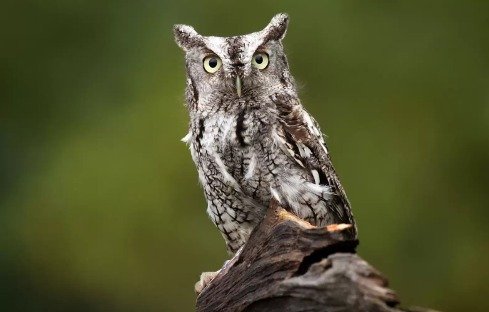
Huddled together, a little family cowered in fear as a harsh storm made their home come tumbling to the ground. The tree they’d been living in had snapped in half. Now that the storm had passed, a work crew was preparing to saw it to pieces.
Luckily, one crew member heard someone calling from inside a log. The curious crew member grabbed the entire log and brought it to the New England Wildlife Center. Carefully, center staff moved the giant piece of tree into an X-ray machine, and their suspicions were confirmed — there were babies inside.

Miraculously, four orphaned owl chicks were alive and well inside the log. Putting the tree into the X-ray machine was an unusual move, but it paid off.
“[X-raying a log] is definitely something that I’ve never done before,” Zak Mertz, New England Wildlife Center CEO, told The Dodo. “But it worked.”
Center staff quickly got busy moving the baby owls out of the log and into the safety of the animal hospital.

The chicks spent a few days at the hospital, where veterinarians monitored them and made sure they were healthy. The babies were resilient and happy to have each other while navigating the new environment.
“They’re pretty tenacious little babies, especially the screech owls,” Mertz said. “When they have each other, they have a much higher level of comfort than when they’re alone.”

Center staff knew that the baby owls should be raised by other owls, so, with the help of an avian biologist, they got to work finding the owls adoptive families.
“The best thing we can do in those situations is not raise them ourselves,” Mertz said. “[We had] to find a surrogate nest, or, in this case, a couple surrogate nests.”
According to wildlife medical director Dr. Priya Patel, baby owls like these receive care and food from their mother for about the first two months of their lives before moving into a “branching” stage. During this time, owl parents watch over them as they learn to fly. It’s at this stage that many baby owls wind up on the ground. Mertz urges community members to check for owl parents before moving any baby owls they may believe to be in danger.

“If you see an owl on the ground, we always advise folks to step back, 15 to 20 minutes, and see if you see a parent in the area,” Mertz said. “And if you don’t, then the best thing to do is to either call a licensed rehabilitator or call the state wildlife agency or someone that can help you catch that bird safely without interfering in the natural process or harming you or the animal.”
Thanks to the quick thinking of so many animal lovers, these baby owls are safe with their surrogate families, getting a second chance at a life in the wild.